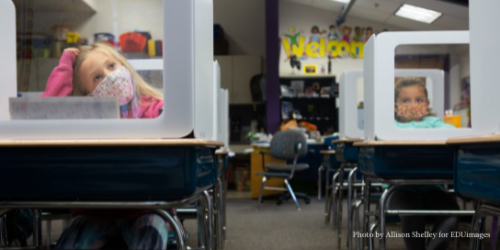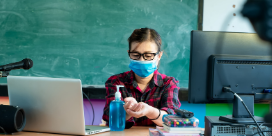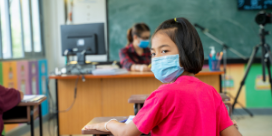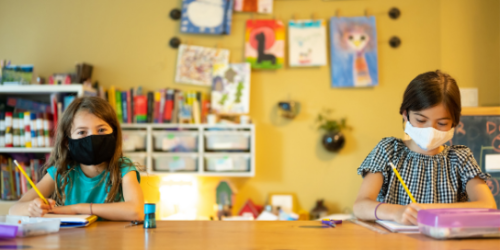We are nearly halfway through the 2020-21 school year, and we seem to be no closer to “normalcy” than when the school year began. As some districts either work to shore up their remote learning plans or begin to implement some version of in-person learning, we want to offer a review of how some of the largest school districts in the country have negotiated their reopening. We also look at some of these districts’ more relevant teacher policies for the coronavirus environment.
To date, NCTQ has analyzed the COVID-19 related memoranda of agreement or understanding (MOAs and MOUs) and board policy changes in 44 school districts, including nine of the top 20 largest districts in the nation. We will continue to add more as they are approved or updated if reopening plans evolve.
Reopening policies
Of the 44 districts analyzed, 42 included some type of remote instruction provision. The predominant mode of instruction in reopening was fully remote, offered by 23 of the districts in our sample. Ten districts offered a hybrid approach (the same group of children attending school in-person some days and remotely on other days), and nine offered some combination of different options (by grade allocation or choice of fully in-person and fully remote, or fully remote and hybrid, etc.). Only two of the districts in our sample (Douglas County School District in Colorado and Sioux Falls School District in South Dakota) had an all in-person reopening.
Of the 42 districts that reopened with at least some remote instruction, only a little over half (23) include live instruction requirements in their MOUs or board policies.
Little Rock School District (AR) and Pinellas County Schools (FL) allow live instruction to be determined by the teacher, while St. Paul Public Schools (MN) specifies that they do not require live instruction at all.
Additionally, only six of the 42 districts that reopened with some sort of remote instruction indicate specific limits to class sizes.
Not surprisingly, most of the districts in our sample have specific provisions to renegotiate instruction modality once there is a change in the health metrics and safety evaluations. These renegotiation provisions exist across the board, regardless of districts’ current modality.
The language in
Boston Public Schools’ MOA stands out as the only district that grants the superintendent the right to terminate the current plan and revert back to the previous collective bargaining agreement.
Health and safety
Of the 23 districts that reopened with some type of in-person instruction, only 13 provide PPE for their teachers, according to the language in their MOUs. Twelve districts include language that indicates both the requirement that students wear a mask as well as the district’s provision of such PPE.
The level of detail on PPE requirements and provisions found in these agreements varies. In Florida, Pinellas County Schools’ MOU is very specific in indicating the provision of five cloth masks for both students and teachers.
Hillsborough County Public Schools‘ MOU (also in Florida) is somewhat vague, indicating that “[t]he district will ensure equipment and supplies are provided to support proper hygiene behaviors, use of PPE and sanitation” for teachers, and “a supply of hand sanitizer” for students. Both of these districts observe a hybrid instruction model and require mask use for both students and teachers.
Douglas County School District’s (CO) board policy states that during in-person instruction, the district will provide gloves, soap, sanitizer, and disinfectant; and face coverings only upon request, while indicating that the teachers should aim to provide their own face coverings. For students, they indicate that the school will provide a face covering if the student comes to school without one. Douglas County’s board policy also requires mask use by both students and teachers.
Sioux Falls School District (SD) has the only MOU out of the 44 districts that explicitly states that both teachers and students are
not required to wear face coverings. Of note, Sioux Falls School District is located in a county with the largest percentage of COVID-19 cases in the sample: 13.1% of their population, compared to an average of 5.5% among the 44 districts.
Teacher evaluation and support
Only 17 of the 44 districts in our sample have specific provisions related to observing and giving feedback to teachers this year, with 27 districts’ MOUs silent on the topic of teacher evaluation, and 14 of those also silent on the topic of professional development.
Teaching issues, reaching students, and technical challenges, are some of the
most cited “worries” of teachers delivering any kind of instruction during this school year. Therefore, it is surprising that a third of all districts in our sample do not mention the use or adaptation of either of these support systems during such an unconventional school year.
Among the districts that address evaluation and feedback in their MOUs, most did so to modify this year’s evaluation practices. For example, 11 of the 17 make a provision for remote observations, and also 11 have agreed on changes to their observation requirements, whether it is their frequency, their timeline, or their formality. However, only five specify that they will continue to use measures of student growth in such evaluations, out of 33 that used them before the pandemic.
Some districts are showing a lot of creativity in their approach to their teacher evaluations.
Denver Public Schools, for example, created different evaluation instruments for each type of learning environment. Both evaluators and teachers are required to be trained, and evaluators are calibrated utilizing the appropriate instrument prior to any evaluations. Hawaii Department of Education continues to use measures of student growth, but modifies expectations to reflect the current environment. The benchmarks for an effective or highly effective teacher have been modified to the levels normally used for novice teachers, which recognizes that all teachers are facing new challenges during this school year.
When it comes to the effects of evaluation on compensation, Dallas Independent School District’s pay scale is and remains entirely dependent on performance. Therefore, they have adapted their evaluation system to reflect the current environment, adopting different metrics for remote instruction compared to in-person instruction. Conversely,
Brevard Public Schools‘ (FL) MOA has suspended all performance pay, although evaluations do continue with some modifications.
Leave
Twenty-six districts in our sample have instituted COVID-19 related leave policies, in addition to what teachers can take under the Family and Medical Leave Act (FMLA). While all teachers were granted 80 hours of leave if subject to quarantine as a result of exposure or a positive COVID-19 test in accordance with the Family First Coronavirus Response Act (FFCRA), this act expired on December 31, 2020. The provision of this type of leave is now
voluntary, and although the new stimulus package provides resources for districts to continue employing their existing staff, it does not provide a blanket protection for school district employees in terms of paid leave.
In the absence of the FFCRA, some districts enacted policies that could bring some relief in case a teacher must quarantine. For example, seven districts specify that teachers who must quarantine but remain asymptomatic are either able or required to continue to teach remotely, in which case no use of leave is necessary.
Six districts provide their employees with leave in addition to the FFCRA in the event of exposure or diagnosis. Brevard Public Schools and Hillsborough County Public Schools in Florida have made available five extra days of sick leave if necessary for continuing COVID-19 symptoms, and
Broward County Public Schools, also in Florida, provides an additional 80 hours of paid sick leave.
Montgomery County Public Schools (MD) has a provision for “unusual and imperative leave” for quarantines that must exceed the provisions of the FFCRA, and the New York City Department of Education has provisions for excused leave at full pay until a teacher has been cleared to return to work, without a charge to leave balances. Finally, Sioux Falls School District (SD) grants their employees eight days of additional leave after the FFCRA leave days expire.
Although not directly related but with impacts on leave and health, Miami-Dade County Public Schools’ MOU stands out for its provision to allow teachers to bring children to work when no childcare is available, and for its elimination of the 90-day waiting period for healthcare.
Recommendations
After observing the outcomes of the first half of the 2020-21 school year, NCTQ’s main recommendations for district and school administrators include:
- Continue to conduct teacher evaluations, focusing on every teacher’s need for observations and feedback. Train and calibrate evaluators on remote observations and feedback, as remote observations might become a regular tool even after the pandemic is over.
- Advocate for student growth data, even if it won’t be used for evaluations this year. It is important to have the data, in order to fine-tune instruction and professional development, as well as provide teachers and school leaders an understanding of student learning gaps.
- Consider leave policies to make up for the expiration of the FFCRA. These policies are not only a necessary safety net, but could also be an important negotiation tool as more districts work to conduct some type of in-person learning.
Resources:
District and State COVID Teacher Policy Tracker SY20-21: A spreadsheet tracker of board policies and policies in formal negotiated agreements between teachers unions and school districts regarding: Health and Safety, Teacher Assignment, Instruction Requirements, Teacher Evaluation, and Teacher Leave Policies. The third tab of the tracker has state guidance and policies on teacher evaluation for SY20-21.
All NCTQ COVID-19 Teacher Policy Response Data and Recommendations: A collection of all the data, analyses, and recommendations NCTQ has provided regarding district and state policy responses to COVID-19 since March 2020.
More like this

What we know (and don’t know) about pandemic-era teacher shortages
National jobs data suggests the wave of predicted teacher resignations has not come to pass.

Leave and health insurance for teachers: safeguards amid COVID-19 worries
In the absence of a federal protection, it becomes the jurisdiction of individual districts to lay out protocols.

Substitute teachers during the pandemic: requirements, benefits, and pay
Although districts reopening schools virtually may have less need for substitute teachers due to teachers’ reduced exposure to illness, districts reopening in-person need more substitutes than normal, as social distance measures reduce class sizes and teachers may be absent more often due to increased exposure to illness.

